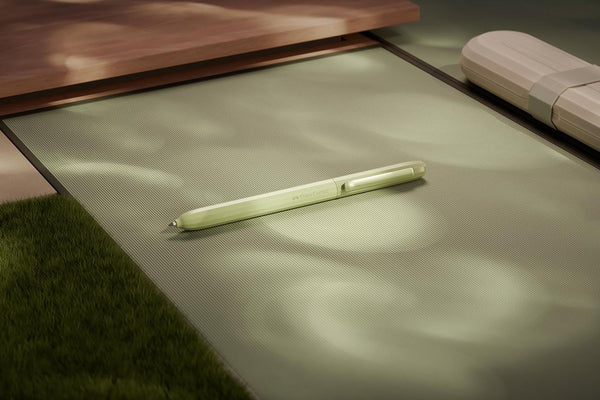Bleeding vs. Ghosting on Paper – What’s the Difference?
Often, when purchasing notebooks and planners in our store, the question arises whether the ink bleeds through to the other side. However, what you usually mean is not bleeding, but rather ghosting. What’s the difference? Let us explain!
We fully understand the dilemmas related to choosing a new notebook. After all, it’s a handy companion to which we often assign many creative tasks. Issues of bleeding and ghosting are therefore extremely important—especially if you regularly use various writing tools such as fountain pens, markers, pens and highlighters, or even paints.
Let’s break down both concepts and consider whether there’s anything to be concerned about and what to pay attention to when choosing a new notebook.
 What does it mean for paper to bleed?
What does it mean for paper to bleed?
We talk about paper bleeding when the ink seeps through the paper and creates unsightly stains visible on the other side. This makes the second side of the page often unusable. Bleeding occurs when the paper is not able to properly hold the ink on its surface. This is an undesirable effect and usually indicates poor paper quality or that the paper’s properties are not suited to more demanding tools.
 What causes ink to bleed through paper:
What causes ink to bleed through paper:
Too much ink flow – fountain pens with thick nibs (above size M), alcohol-based markers, or water-thinned paints can cause bleeding—especially when used on paper with a weight below 140 gsm.
Layering – bleeding can also occur when applying multiple layers of ink in one spot. This leads to the material becoming oversaturated, weakening its structure as a result.
Paper weight – papers with a weight below 80 gsm, if they are not of adequate quality (such as the excellent and ultra-thin Tomoe River from Japan), are generally more prone to bleeding.
Paper texture – paper with a high degree of porosity, which is not smooth, will also be more susceptible to bleeding. These properties cause the paper to absorb ink too deeply.
On the left – the tool used; on the right – ink bleeding:
 If you regularly use tools like permanent markers, alcohol-based markers, or paints, it would be safer to visit an art store and purchase a professional sketchbook with high-weight paper designed for these specific writing tools.
If you regularly use tools like permanent markers, alcohol-based markers, or paints, it would be safer to visit an art store and purchase a professional sketchbook with high-weight paper designed for these specific writing tools.
Wondering what terms like paper weight, uncoated paper, or smoothness level mean? Check out the article where we explain these concepts and present the properties of the paper in our notebooks.
What does ghosting on paper mean?
Ghosting occurs when the image or text from one side of a sheet is visible (though not necessarily readable) on the other side of paper. This is largely related to the transparency of the paper and its degree of light transmission, which are influenced by the paper’s composition, weight, and fiber structure. Ghosting is a completely natural phenomenon and commonly found in books or calendars, and usually does not affect the comfort of use or the functionality of a notebook.
Key factors affecting show-through:
Paper weight – the thinner and lighter the paper, the more likely it is to show through. Paper with a lower weight (e.g., 60-80 gsm) is more prone to show-through than paper with a higher weight (e.g., 120-160 gsm).
Material content – the type of fibers used in paper production also influences transparency. Paper made from more translucent fibers, such as chemically processed cellulose, may have a greater tendency to show through.
Paper structure – irregularly distributed fibers and more empty spaces between them increase ink penetration, which in turn intensifies ghosting. Paper with an uneven structure and high porosity is therefore generally more prone to show-through.
Ink used – its quantity, quality, and intensity. Ghosting is most noticeable after using darker inks but can also occur if someone has a bold writing style and likes to press the nib firmly when writing.
 Ghosting in our store’s paper products
Ghosting in our store’s paper products
In our offer, you will find planners and notebooks that are perfect for everyday writing with fountain pens, ballpoint pens, fineliners, rollerball pens, and pencils.
In most cases, you also don’t need to worry about water-based brush pens and highlighters—they will show through slightly but shouldn’t bleed through the page. We’ve tested them on our own paper collections and can wholeheartedly recommend them for daily use without fear of colored pigments bleeding through to the other side. The paper in products from our collection is very smooth, and its optimal weight of 100 gsm makes it sufficiently dense to minimize the risk of bleeding.
On the left – test of various writing tools; on the right – degree of ghosting:
 The paper weight in the products from our shop's offer ranges from 90 to 120 gsm, so slight ghosting on the other side is natural. However, this doesn’t affect the everyday use of the notebooks in any way and can even add a charming touch. Ghosting is like an echo of the story written on the previous page. Admit it—it has its own charm! <3
The paper weight in the products from our shop's offer ranges from 90 to 120 gsm, so slight ghosting on the other side is natural. However, this doesn’t affect the everyday use of the notebooks in any way and can even add a charming touch. Ghosting is like an echo of the story written on the previous page. Admit it—it has its own charm! <3Text: Lena Pilarczyk
Images: Kasia Fus, Magdalena Konik-Machulska

















